Legal aid statistics England and Wales bulletin Jul to Sep 2020
Published 17 December 2020
We are seeking user feedback on the use of HTML for the publication of statistical bulletins. Please send any comments to: statistics@justice.gov.uk.
Main Points
Figures for this latest quarter continue to be impacted by the COVID-19 pandemic with courts and other parts of the justice system running a reduced service.
| Overall Crown Court expenditure decreased this quarter; down by 60% compared with the same period of the previous year. | ⬊ | This is driven by falling trial completions in the Crown Court, with trial expenditure in the graduated fee schemes falling by more than 75% over the same period. | ||
| The volume of completed work in magistrates’ courts decreased by 17%. | ⬊ | Magistrates’ court expenditure fell 23% over the same period. | ||
| Representation orders granted in magistrates’ court declined 6% while Crown Court increased by 5%. | ⬊ | The early workload indicators for court volume show work arriving at the Crown Court and increasing the eventual fee payments. | ||
| Mediation Information and Assessment Meeting volumes were 8% higher than in the same quarter of 2019. | ⬈ | Mediation outcomes were unchanged and starts were 3% lower over the same period. | ||
| Applications for civil representation supported by evidence of domestic violence or child abuse decreased by 22%. | ⬊ | The total volume of these granted decreased by 23% compared to the same period of 2019. | ||
| 837 applications for Exceptional Case Funding were received in the last quarter. | ⬊ | This is an 8% decrease from the same quarter last year. |
This edition comprises the first release of official statistics for the three-month period from July to September 2020 and the latest statement of all figures for previous periods. In addition, section 6 presents provisional figures for October 2020 based on management information. For more detailed commentary, and statistics on providers of legal aid, Central Funds and legal aid in the higher courts, please refer to the annual publication
For technical detail, please refer to the User guide to legal aid statistics.
Statistician’s Comment
This publication shows that workload and expenditure has continued to fall this quarter, due to COVID-19, across almost all legal aid schemes.
Criminal legal aid figures show decreases in expenditure compared to the same quarter last year in schemes that support the court system including the magistrates’ and Crown Court. The incoming workload for representation at the courts has returned to levels seen in the previous year. Complex trial cases ongoing at the Crown Court are not completing due to social distancing measures and reduced capacity in the courts which is impacting closed claim expenditure.
Civil legal aid figures show a mixed picture on volumes and expenditure compared to the same quarter last year, but there are increases across most schemes overall since last quarter. Civil representation applications and mediation workload have returned to levels seen previously, but legal help starts and claims remain much lower than last year. Applications for domestic violence cases have seen the biggest increase since last year.
Section 6 presents provisional figures for October 2020 based on management information. October 2020 figures begin to show a recovery from the impact of COVID-19 in terms of work starting in criminal legal aid, with court representation applications up by 15% in the Crown Courts and 1% in magistrates’ courts compared to the average of the previous quarter. Within civil legal aid, legal help starts increased in October 2020 compared to the average of the previous quarter, with a smaller increase in civil representation applications. It is expected that criminal and civil legal aid volumes will return to, and may temporarily exceed, historic trend levels.
Things you need to know
These symbols are used throughout this release to navigate to other documents of interest:
| Web Tool | Help | Tables |
| Click for tool allowing user-definied charts and tables | Click for document giving definitions and explanations | Click for access to tables of figures |
To understand trends in legal aid as a whole, it is best to begin by looking at annual expenditure figures and then look at trends in both workload and expenditure for each category of legal aid. Summarising activity across the legal aid system meaningfully within a single number is difficult because of the diversity of services included. Expenditure on legal aid is measured differently for different purposes. The three most often-used measures, shown in Figure 1, are:
-
Closed-case expenditure is the measure used for expenditure figures throughout these legal aid statistics. It represents the total value of payments made to legal aid providers in relation to pieces of work that are completed in the period. This basis is comparable to volumes of completed work to which it relates, and to the same fine level of detail. This does not include income received or expenditure in relation to debt write-offs.
-
RDEL (Resource Departmental Expenditure Limits) nominal is the main budgeting measure used by government to control current spending, both to set budgets for future years and report on how much has been spent. It represents the value of work carried out in the period better than the closed-case measure but cannot be broken down to such a fine level of detail. This measure does incorporate income and expenditure in relation to debt. Nominal here means not adjusted for inflation.
-
RDEL real is the RDEL measure adjusted for inflation to make the value of spending in previous years directly comparable with the specified year.
These measures show a large reduction in legal aid expenditure from around 2010-11, mostly due to changes to the scope of civil legal aid introduced by the Legal Aid, Sentencing and Punishment of Offenders (LASPO) Act from 2013-14, reductions in criminal legal aid workloads and reductions in the fees payable to legal aid providers.
Figure 1: Overall annual legal aid expenditure, by closed-case and RDEL nominal and real terms measures (£m), 2005-06 to 2019-20
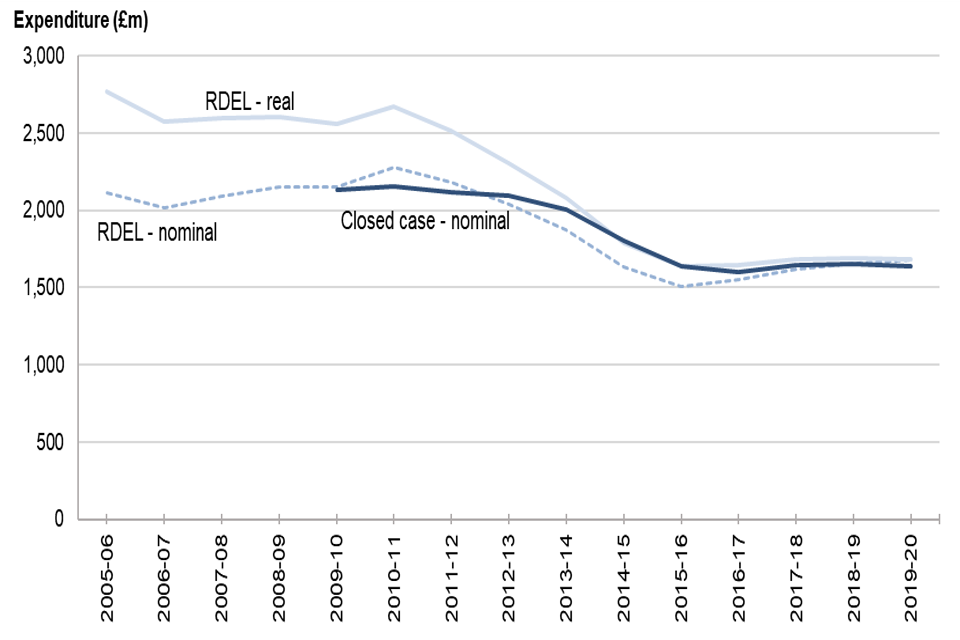
Figure 1: Overall annual legal aid expenditure, by closed-case and RDEL nominal and real terms measures (£m), 2005-06 to 2019-20
Criminal legal aid
| Web Tool | Help | Tables |
Overall Crown Court expenditure decreased this quarter; down by 60% in July to September 2020 compared with the same period of the previous year. This is driven by a falling volume of completed trials in the Crown Court due to the ongoing pandemic, with trial expenditure in the graduated fee schemes falling by more than 75% over the same period.
Criminal legal aid can be categorised into Crime Lower and Crime Higher. Crime Lower includes police station advice, magistrates’ court and prison law. Crime Higher covers work in the Crown and Higher Courts.
Figure 2: Crime overview, closed case volumes and expenditure for July to September 2020, and comparison with July to September 2019
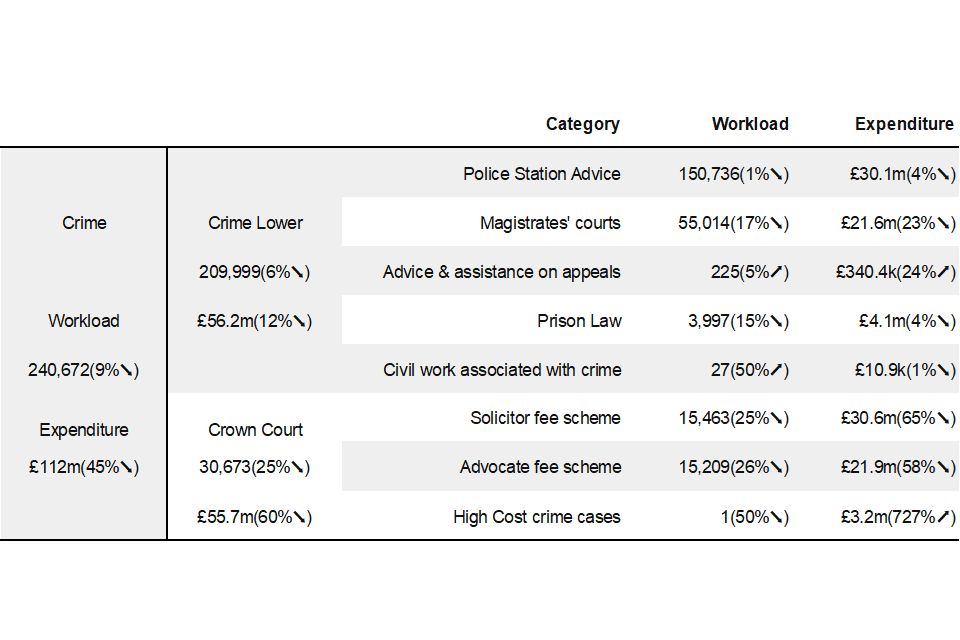
Figure 2: Crime overview, closed case volumes and expenditure for July to September 2020, and comparison with July to September 2019
Although Crown Court work comprises a relatively small portion of criminal legal aid in terms of volume, it usually accounts for around two-thirds of all criminal legal aid expenditure. However, due to the impact on court hearings and the lack of courtroom availability for jury trials this has fallen to just under half of all criminal legal aid expenditure this quarter.
Advice relating to the police station makes up the largest portion of workload, but a much smaller proportion of expenditure.
Figure 3a: Workload in criminal legal aid, April to June 2011 to July to September 2020

Figure 3a: Workload in criminal legal aid, April to June 2011 to July to September 2020
Figure 3b: Expenditure in criminal legal aid, April to June 2011 to July to September 2020
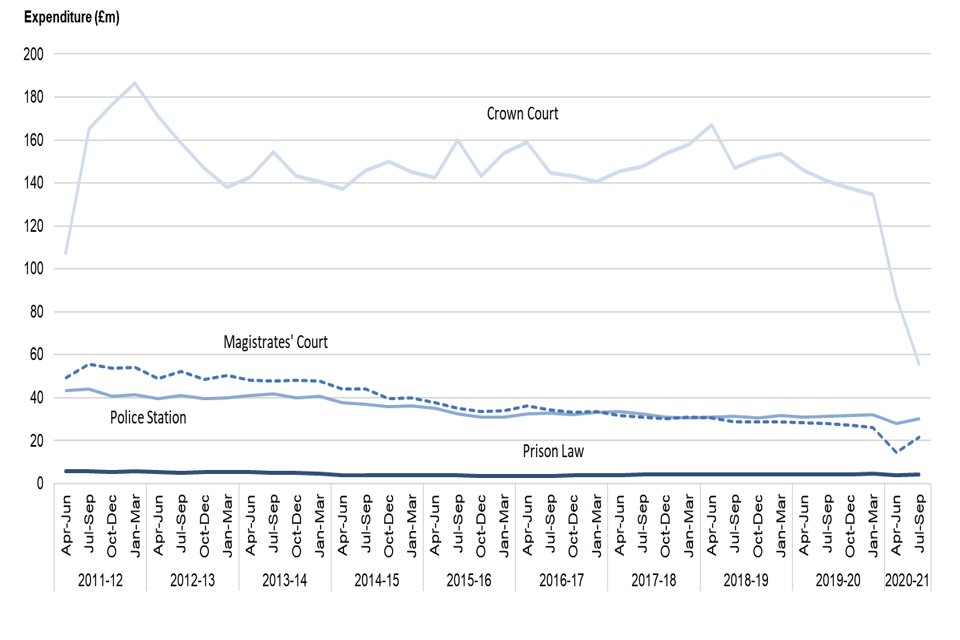
Figure 3b: Expenditure in criminal legal aid, April to June 2011 to July to September 2020
Note: Advice and assistance on appeals and civil work associated with crime are excluded from these figures.
Police station advice
This category made up more than two thirds of the overall Crime Lower workload between July and September 2020 and half of the expenditure. The workload in this period has decreased by 1% compared to the previous year, with expenditure decreasing by 4% (£1.4m). The decrease in police station advice workload since 2013-14 is also seen in arrest statistics for England and Wales , which has had a similar decline historically.
The majority of the police station advice workload (85% in July and September 2020) consists of suspects receiving legal help with a solicitor in attendance at the police station, with the rest mainly consisting of legal advice over the telephone.
Applications and grants for representation in the criminal courts
While figures should be interpreted with caution as they may be revised in subsequent quarters as cases move into the Crown Court, the number of orders granted for legally-aided representation in the magistrates’ courts decreased by 6% this quarter when compared to the same quarter of the previous year. This is largely due to the impact of COVID-19 but continues the downward trend of the last few years, which has been largely driven by summary only cases. The overall number of receipts in the magistrates’ courts[footnote 2] including those not involving legal aid showed a larger decrease (36% down) over the same period with the largest fall (66%) in summary non-motoring offences. The proportion of these applications that are granted remains stable at around 95%.
Orders granted for legally-aided representation in the Crown Court increased by 5% this quarter compared to last year. Reduced hearings at the lower court in previous periods are now being actioned, causing an increase in the workload for the Crown Court, with representation slightly above levels previously seen. There was also a 7% increase in all Crown Court receipts[footnote 3] during the same period. Within the legal aid figure, orders relating to either-way offences increased by 6%, while those relating to indictable offences increased by 14%. The proportion of Crown Court applications granted remains at almost 100%.
Magistrates’ court completed work
Legally-aided representation in the magistrates’ courts comprised more than one quarter of the workload and almost 40% of expenditure in Crime Lower between July and September 2020. These compare to usual proportions of around one-third of workload and around half of expenditure, showing that court work has fallen more during this period than police station workload.
The volume of completed work in the magistrates’ courts decreased by 17% this quarter when compared to the same period of the previous year. Expenditure decreased by 23%, following the trend in volumes within this predominantly fixed fee claim area. The fall in expenditure is slightly higher than the fall in workload due to larger drops seen in non-standard claims as these are usually more expensive claims.
Crown Court completed work
Completed work volumes within the litigator (solicitor) fee scheme decreased by 25% in July to September 2020 compared to the same period of the previous year, driven mainly by a 74% decrease in completed cases where the defendant has plead not guilty and will require a courtroom that allows a full jury.
In the advocate fee scheme, the number of completed claims decreased by 26% compared to the same period last year, largely due to a 72% fall in the number of trials completed and the rising backlog of those requiring a jury trial.
Figure 4a: Workload in the Crown Court, April to June 2011 to July to September 2020
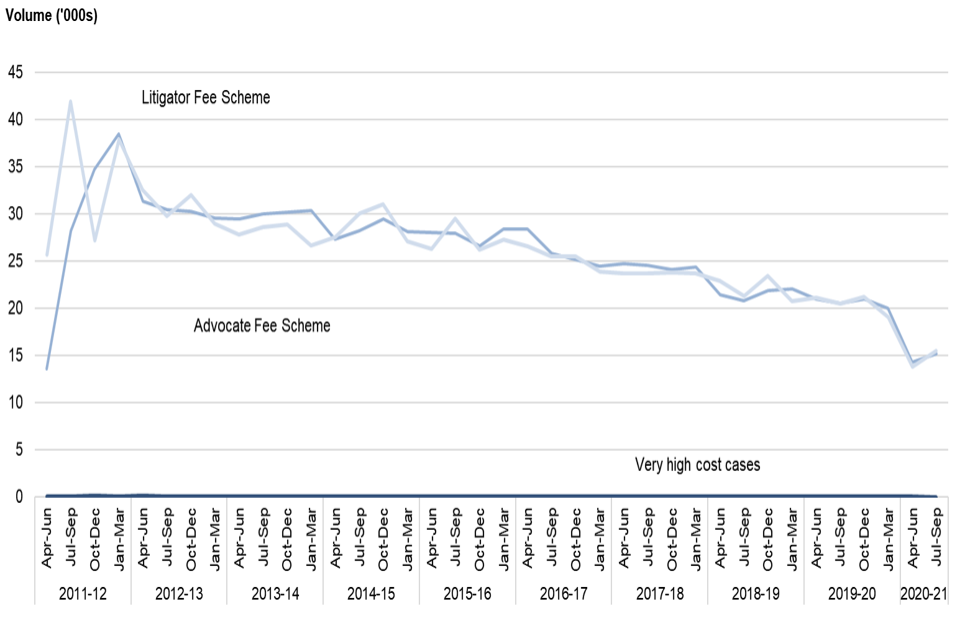
Figure 4a: Workload in the Crown Court, April to June 2011 to July to September 2020
In the litigator fee scheme, expenditure decreased by 65% in July to September 2020 compared to the same period of the previous year. In the advocate fee scheme, the value of payments decreased by 58% compared to the same period of the previous year.
These falls are driven by large decreases in the volume and subsequent expenditure on trials. The litigator fee scheme fell by 74% in volume and 80% in expenditure, and the advocate fee scheme fell similarly, with a drop of 72% in volume and 78% in expenditure.
Figures for expenditure on work completed in the Crown Court should be interpreted with caution as they may be revised in subsequent quarters as claims are assessed further on appeal and further payments added to the value of some completed claims.
Figure 4b: Expenditure in the Crown Court, April to June 2011 to July to September 2020
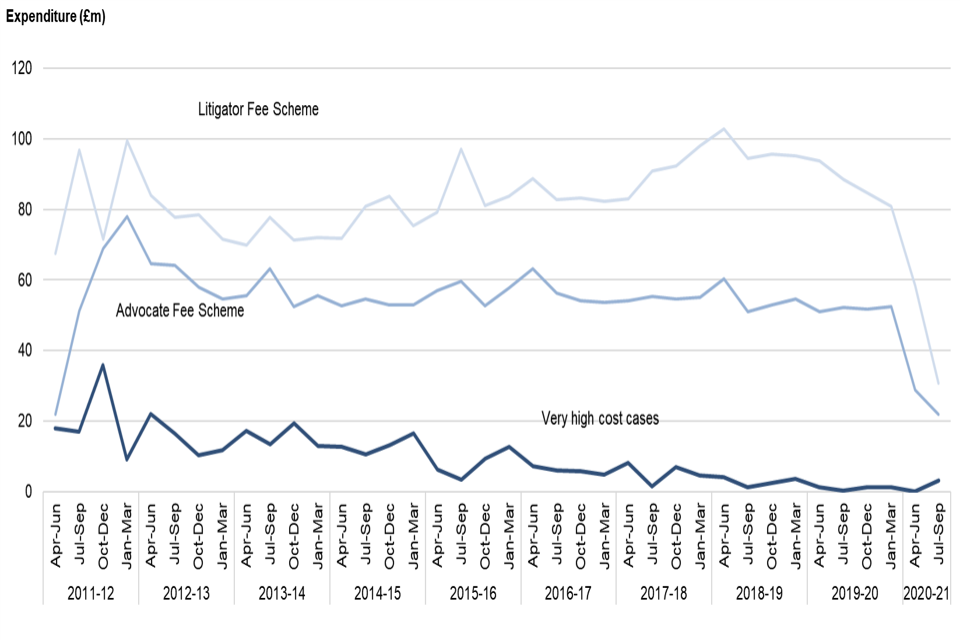
Figure 4b: Expenditure in the Crown Court, April to June 2011 to July to September 2020
The large falls in completed expenditure are a consequence of the large fall in the number of jury trials completing in the Crown Court (as all expenditure across the case will be in the final main bill). Figure 4c below, looking at the litigator fee scheme in isolation but equally applicable to both schemes, shows the impact of falling trials on expenditure – these types of cases are more likely to be impacted as they need more courtroom space and distancing measures and are likely to include witnesses and members of the public in the jury pool.
Trial completed expenditure has been more adversely affected than guilty pleas and cracked trials, (where a defendant changes their plea before the trial), with litigator fee expenditure much lower previously it was more than £60m and is now around a quarter of this. A lack of available resources has led to less jury trials with a subsequent increase in trials awaiting completion by 52%[footnote 4].
Figure 4c: Litigator Fee Scheme Crown Court workload and expenditure by claim type, April to June 2017 to July to September 2020
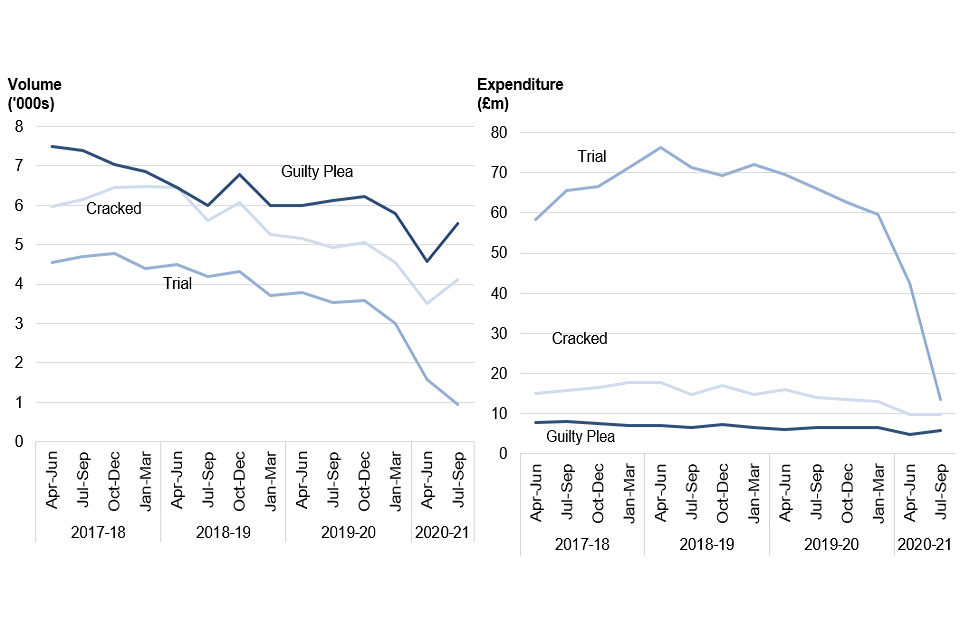
Figure 4c: Litigator Fee Scheme Crown Court workload and expenditure by claim type, April to June 2017 to July to September 2020
The Very High-Cost Case (VHCC) scheme covers those Crown Court cases which, if the case were to proceed to trial, would likely last more than 60 days. These cases can span several years and, while they may involve small numbers of defendants, the associated expenditure is high in comparison.
There was 1 defendant represented in the VHCC contracts that concluded in the July to September 2020 quarter. Expenditure on this work over the duration of the contracts within this claim (i.e. on the closed-case basis) was £3.2m. While workload comprises a tiny proportion of legal aid in the Crown Court overall, the VHCC scheme represents around 6% of the cost this quarter, higher than recently and partly down to reduced overall graduated fee expenditure, although down from over 15% ten years ago.
Prison Law
Workload this quarter decreased by 15% compared with the same period in the previous year, driven by advocacy at prison disciplinary hearings which decreased by 79% compared to last year (see figure 5). This category previously made up over one-third of prison law workload, but this has fallen to less than 10% during this period. This large fall contrasts with increases in workload in both other categories in prison law.
Expenditure on prison law fell 4% following the overall trend of the quarter (see Figure 5b). This was in part driven by the large fall in prison disciplinary hearings. However, this drop was masked by increases in workload for advocacy at parole boards. These had a 27% increase in workload and 10% decrease in expenditure compared to the previous year.
Figure 5a: Prison Law completed workload, April to June 2011 to July to September 2020
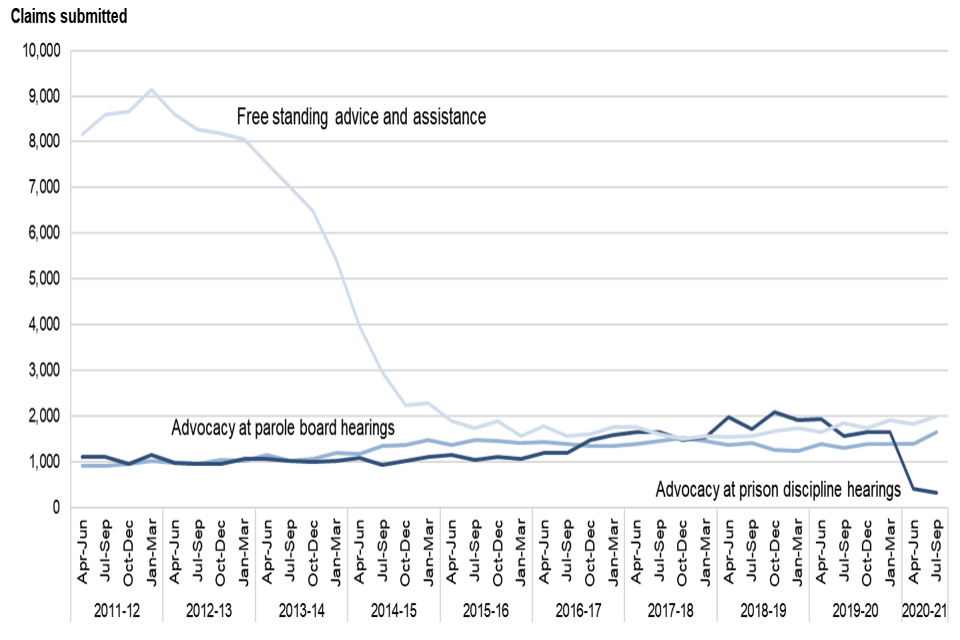
Figure 5a: Prison Law completed workload, April to June 2011 to July to September 2020
Figure 5b: Prison Law completed expenditure, April to June 2011 to July to September 2020
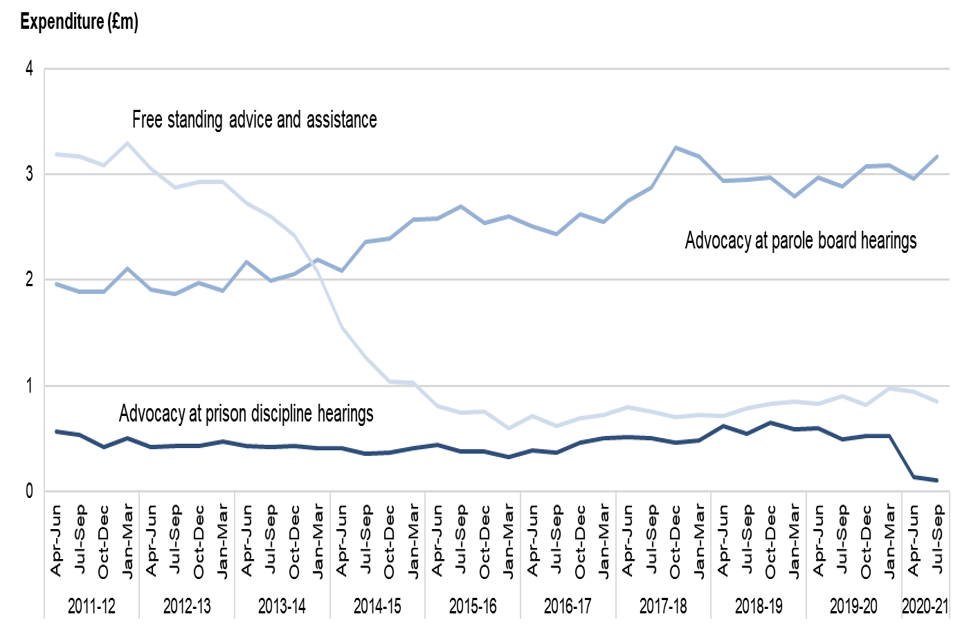
Figure 5b: Prison Law completed expenditure, April to June 2011 to July to September 2020
*New categories not shown: ‘advocacy assistance at sentence reviews’ and ‘advocacy assistance at Parole Board reconsideration hearings’
Civil legal aid
| Web Tool | Help | Tables |
Overall civil legal aid expenditure decreased this quarter; down by 16% in April to June 2020 compared with the same period of the previous year. The COVID-19 pandemic has impacted on volumes and expenditure across all civil legal aid schemes, and most matter types. Larger decreases were seen in non-family volumes (down 27%) and expenditure (down 32%) compared to family schemes.
Figure 6: Civil overview, closed case volumes and expenditure for July to September 2020, and comparison with July to September 2019
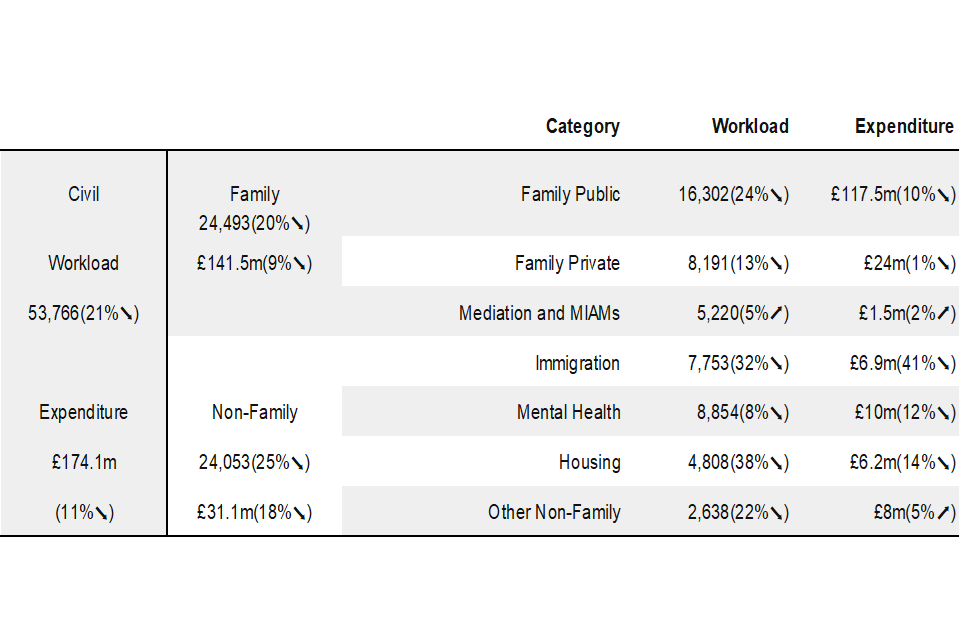
Figure 6: Civil overview, closed case volumes and expenditure for July to September 2020, and comparison with July to September 2019
*Not included in Family total
**Table does not include Housing Possession Court Duty Scheme
Legal help and controlled legal representation
In the last quarter, there was an 21% decrease in legal help new matter starts compared to the same period of 2019. The volume of completed claims decreased by 25% and expenditure decreased by 27% in July to September 2020 compared to the same period in 2019 (Figure 7). The implementation of the LASPO Act in April 2013 resulted in large reductions in legal help workload, with the overall trend falling to less than one-third of pre-LASPO levels.
There is some evidence that legal help volumes are starting to recover, but they are not yet back to pre-pandemic levels. Compared to the previous quarter (April to June 2020), there was a 20% increase in legal help matter starts, with a smaller 2% increase in completed claims. Expenditure was 5% lower.
Figure 7a: Completed workload in legal help and controlled legal representation, April to June 2011 to July to September 2020
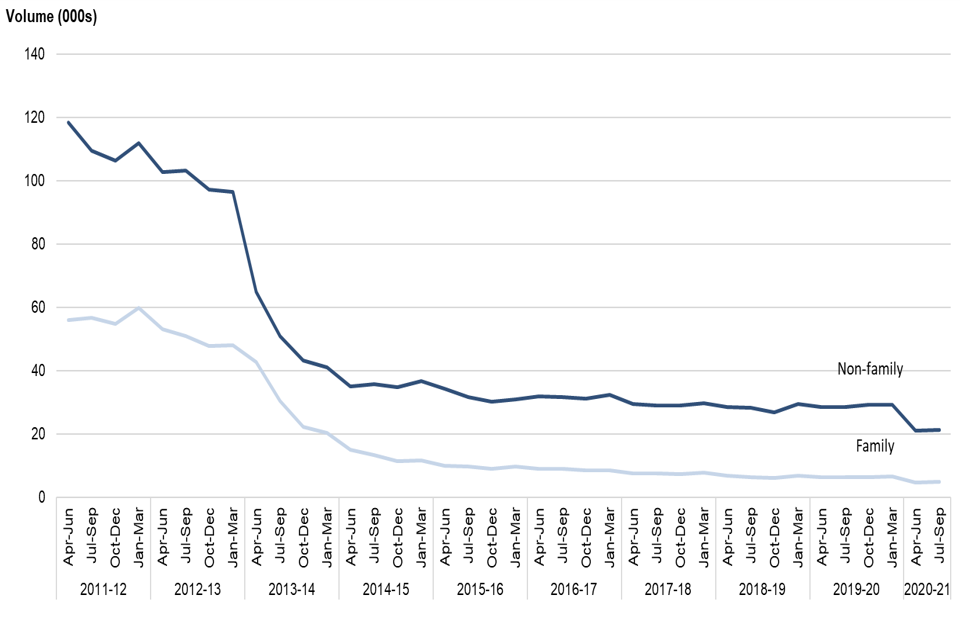
Figure 7a: Completed workload in legal help and controlled legal representation, April to June 2011 to July to September 2020
Figure 7b: Completed workload expenditure in legal help and controlled legal representation, April to June 2011 to July to September 2020
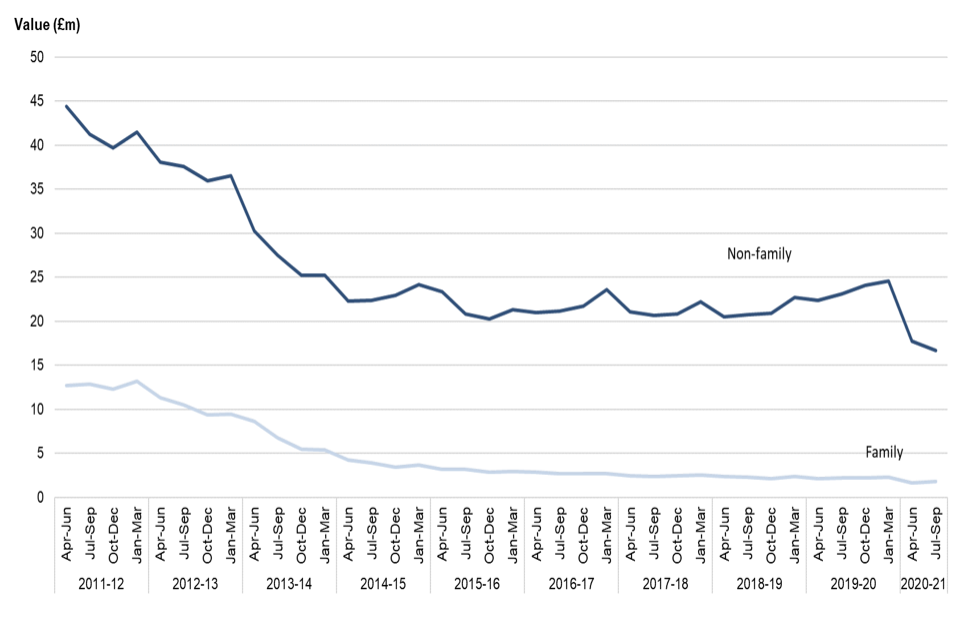
Figure 7b: Completed workload expenditure in legal help and controlled legal representation, April to June 2011 to July to September 2020
Family legal help
In July to September 2020, family legal help starts decreased by 20% compared to the same quarter last year. Completed claims also decreased by 22% and expenditure decreased by 17%. However compared to the previous quarter, there were increases across starts (8%), completed claims (7%) and expenditure (12%) in family legal help cases.
In family mediation, Mediation Information and Assessment Meetings (MIAMs) increased by 8% in the last quarter compared to the previous year, while starts decreased by 3% and outcomes decreased by 1%. These volumes are comparable to pre-pandemic levels and show almost full recovery, which may be in part due to changes in how in the service is operated; sessions can take place via video link.
Figure 8: Family mediation assessments, starts and agreements, April to June 2011 to July to September 2020
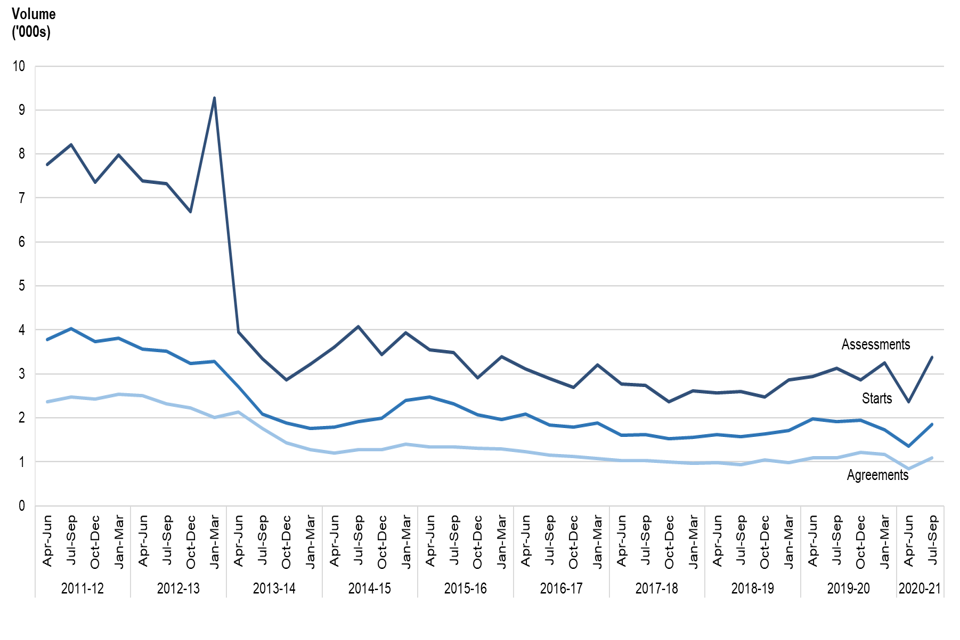
Figure 8: Family mediation assessments, starts and agreements, April to June 2011 to July to September 2020
Non-family legal help and controlled legal representation
Legal help and controlled legal representation make up over 95% of both immigration and mental health cases. Controlled legal representation relates to representation at tribunal and is often longer and more costly than legal help but, as with legal help, the decision on whether to grant legal aid is delegated to providers.
The LASPO Act 2013 made changes to the scope of legal aid for immigration law, but some areas remained in scope. Workload that remains in the immigration category consists largely of asylum-related work. Having fallen by 40% over the 5 years to 2013-14, new matter starts in immigration decreased by 15% in July to September 2020 compared to the same quarter of the previous year. Completed claims in immigration decreased by 32% in the last quarter compared to the previous year and expenditure decreased by 41%. There is some evidence of recovery in immigration workload, with a 50% increase in new matter starts compared to the previous quarter.
Within mental health, most funding is spent on providing assistance to sectioned clients appealing the terms of their detention before a mental health tribunal. Mental health new matter starts decreased by 5% when comparing the latest quarter to the previous year. Completed claims decreased by 8% and expenditure decreased by 16% over the same period. Mental health new matter starts did not decrease as much as other categories of law in recent months and saw an 11% increase compared to the previous quarter, with smaller increases in completed claims (5%) and expenditure (1%).
Over 80% of housing work volume is made up of legal help. The volume of legally-aided housing work halved between July to September 2012 and July to September 2013. The trend then fluctuated for around 18 months but since 2014 it has been falling. In July to September 2020 there was a 46% decrease in housing work starts compared to the same quarter the previous year. There were also decreases in completed claims (41%) and decreases in expenditure (30%). Similarly to other legal help categories of law, this quarter showed an increase of 29% in new matter starts compared to the previous quarter, but decreases in completed claims (11%) and expenditure (9%).
Civil representation
The number of civil representation certificates granted in the last quarter did not change compared to the same period of the previous year and appear to have recovered to expected levels. The number of certificates completed decreased by 20%, and the associated expenditure decreased by 8% over the same period. Completed claims were down 4% and expenditure up 7% compared to the previous quarter.
Figure 9a: Completed workload in civil representation, April to June 2011 to July to September 2020
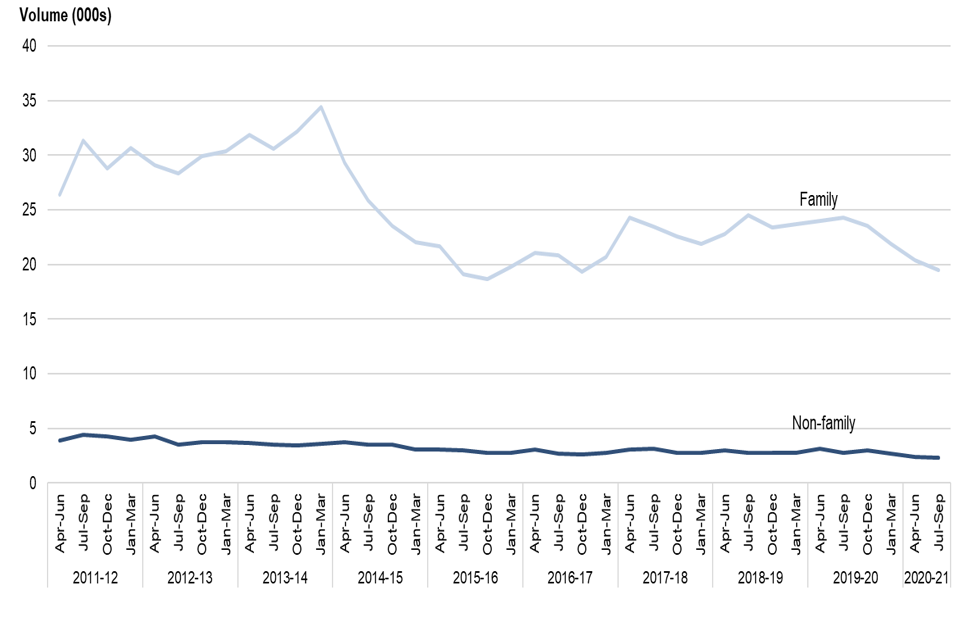
Figure 9a: Completed workload in civil representation, April to June 2011 to July to September 2020
Figure 9b: Completed workload expenditure in civil representation, April to June 2011 to July to September 2020
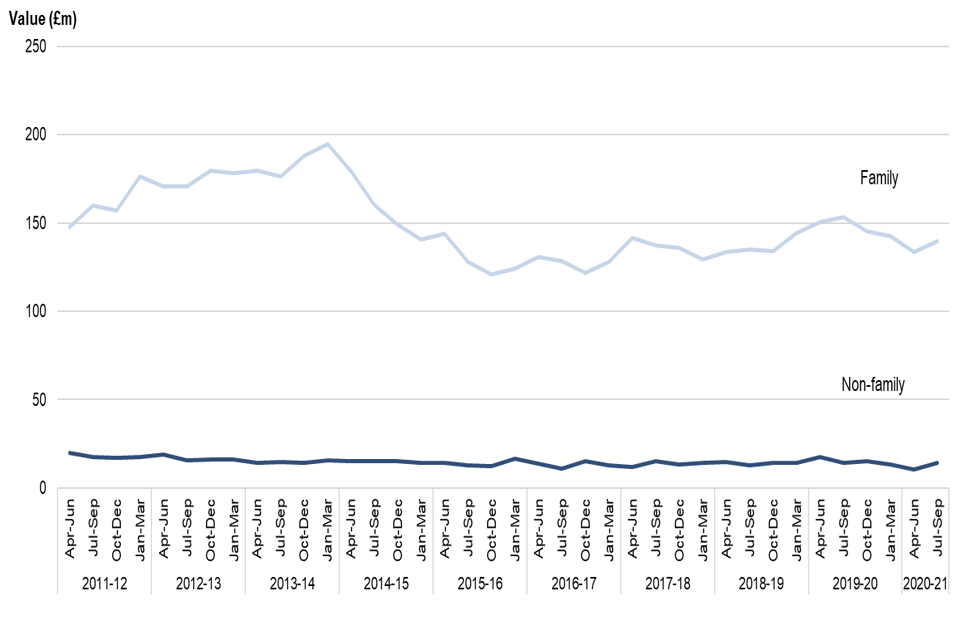
Figure 9b: Completed workload expenditure in civil representation, April to June 2011 to July to September 2020
Family civil representation
Certificates granted for family work increased by 6% in July to September 2020 compared to the previous year. Certificates completed decreased by 20% and expenditure decreased by 9% compared to the same quarter the previous year. Compared to the previous quarter, certificates granted increased by 18%, certificates completed decreased by 4% and expenditure increased by 5%.
In July to September 2020, applications for civil representation supported by evidence of domestic violence or child abuse decreased by 22% compared to the same period of the previous year. The total number of these granted decreased by 23% over the same period. Compared to the previous quarter, applications increased by 25% and grants by 28%. Applications and grants in this category had been falling since October to December 2019 having been rising since the inception of the scheme.
The proportion of applications granted remained steady at around 70% from the inception of this type of application until the end of 2015, before increasing to over 80%. The provisional figure for the latest quarter is 85%.
Figure 10: Applications received and certificates granted via the domestic violence and child abuse gateway, April to June 2013 to July to September 2020

Figure 10: Applications received and certificates granted via the domestic violence and child abuse gateway, April to June 2013 to July to September 2020
Judicial reviews
Of all civil representation applications granted, around 3,000 a year relate to judicial review; 698 in the last quarter. The number granted in July to September 2020 increased by 7% compared with the same quarter in 2019. Over half of judicial reviews were for public law and a quarter were for immigration cases.
Exceptional Case Funding (ECF)
There were 837 applications for ECF received from July to September 2020. This is an 8% decrease from the same quarter last year. 772 (92%) of these were new applications.
Of the 837 ECF applications received between July and September 2020, 97% (811) had been determined by the LAA as of 01 December 2020. 71% (574) of these were granted, 13% (108) were refused and 13% (103) rejected (see figure 11).
Figure 11: Volume of ECF applications received, April to June 2014 to July to September 2020
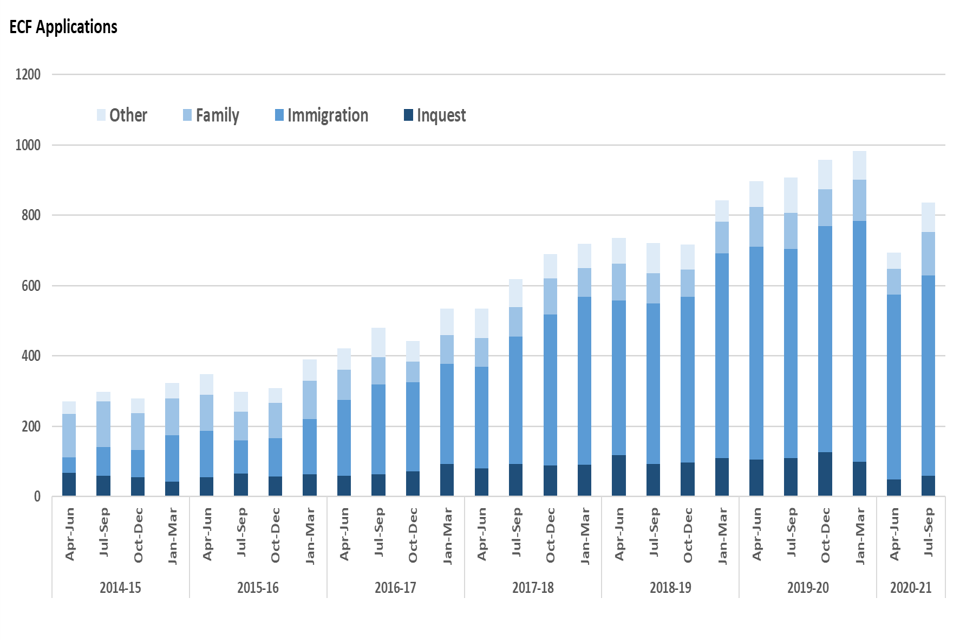
Figure 11: Volume of ECF applications received, April to June 2014 to July to September 2020
Among the ECF applications received between July and September 2020, immigration (68%), inquest (7%), and family (15%) remained the most requested categories of law. The increase in ECF applications over the last two years is driven by an increase in immigration applications.
Figure 12: Volume of ECF determinations by outcome, April to June 2015 to July to September 2020
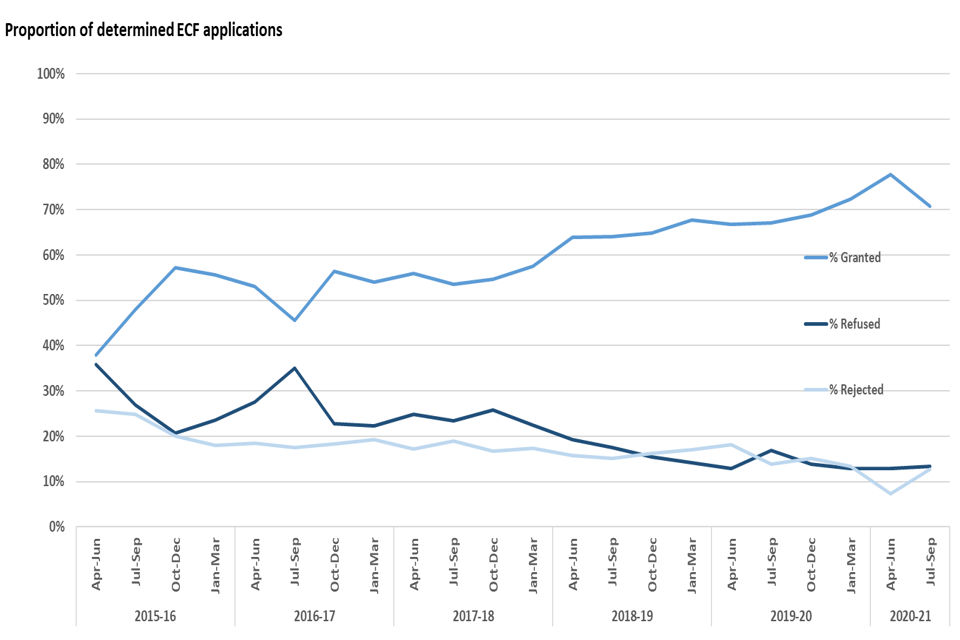
Figure 12: Proportion of ECF determinations by outcome, April to June 2015 to July to September 2020
Early assessment of the impact of COVID-19 on legal aid activity up to end of October 2020
The majority of information in this National Statistics release covers activity up to the end of September 2020. To address growing public interest, and provide the most timely information available on the impact of the COVID-19 pandemic on legal aid, management information up to the end of October 2020 has been analysed. Monthly figures from October 2019 to October 2020 are published in the accompanying tables (Table 12_1).
This section presents headline activity figures for criminal and civil legal aid. No information has been included on expenditure as these figures are subject to greater revision. The methodology is the same as that included in the main National Statistics release. However, quality assurance of the underlying management information has not been undertaken to the same level of checks needed to meet National Statistics standards. Figures should therefore be treated as preliminary and indicative.
This analysis should be treated as provisional information providing a high-level estimate of legal aid volumes in October 2020. As application and starts volumes across most schemes appear to be returning to expected levels, some or all of this section may be removed for future releases. Ongoing monitoring of volumes will continue, and management information will be published where beneficial to users.
Criminal legal aid
Police station attendance
- Provisional figures[footnote 5] show that there has been a 9% decrease in police station attendance in October 2020 (39,000) compared to the monthly average between July and September 2020 (42,800 per month)
Applications received for representation in Crown Courts
- Provisional figures show that there has been a 1% increase in applications received for representation in the Crown Courts in October 2020 (8,200) compared to the monthly average between July and September 2020 (8,000 per month)
Applications received for representation in magistrates’ courts
- Provisional figures show that there has been a 15% increase in applications received for representation in the magistrates’ courts in October 2020 (18,700) compared to the monthly average between July and September 2020 (16,200 per month)
Civil legal aid
Legal help
- Provisional figures[footnote 6] show that there was a 17% increase in legal help new matter starts in October 2020 (9,500) compared to the monthly average between July and September 2020 (8,100 per month). Family starts increased by 12% and non-family increased by 18% over the period.
Housing Possession Court Duty Scheme
- There have been no Housing Possession Court Duty Scheme (HPCDS) starts since April 2020 compared to an average monthly figure of 2,400 per month between January and March 2020.
Family mediation assessments
- Family mediation starts, assessments and outcomes have all returned to expected levels in the latest quarter. The provisional October figures are lower, but this is likely due to early extraction of data.
Civil representation applications
- Civil representation applications have also returned to expected levels in the latest quarter, and provisional October figures are consistent with this.
Further information
This publication presents quarterly data trends and the figures published annually, including those on the diversity of clients, the providers of legal aid, appealing legal aid decisions, Central Funds and legal aid in the higher courts.
Our statisticians regularly review the content of publications. Development of new and improved statistical outputs is usually dependent on reallocating existing resources. As part of our continual review and prioritisation, we welcome user feedback on existing outputs including content, breadth, frequency and methodology. Please send any comments you have on this publication including suggestions for further developments or reductions in content.
National Statistics status
National Statistics status means that official statistics meet the highest standards of trustworthiness, quality and public value. All official statistics should comply with all aspects of the Code of Practice for Official Statistics.
They are awarded National Statistics status following an assessment by the Authority’s regulatory arm. The Authority considers whether the statistics meet the highest standards of Code compliance, including the value they add to public decisions and debate.
It is the Ministry of Justice’s responsibility to maintain compliance with the standards expected for National Statistics. If we become concerned about whether these statistics are still meeting the appropriate standards, we will discuss any concerns with the Authority promptly. National Statistics status can be removed at any point when the highest standards are not maintained, and reinstated when standards are restored.
Contact
Press enquiries should be directed to the Ministry of Justice press office: Tel: 020 3334 3536 Email: newsdesk@justice.gsi.gov.uk
Other enquiries about these statistics should be directed to the Justice Statistics Analytical Services division of the Ministry of Justice:
Liz Whiting, Head of Legal Aid Statistics
Ministry of Justice, 102 Petty France, London, SW1H 9AJ
Tel: 07540 263147
Email: statistics@justice.gov.uk
Tables
-
A set of ‘Tables’, which give further detail and full time-series for each area.
-
More detailed data and Civil detail data: Detailed files to enable independent analysis, provided in .ods (OpenDocument Spreadsheet) format.
Help
-
User Guide to legal aid statistics: This provides comprehensive information about data sources as well as key legislative changes.
-
Index of data in Legal aid statistics: A guide to the data published in the .ods files, lists of available data from Legal Aid systems and guidance on how to work with the data.
-
Quality Statement: This provides detail on how legal aid statistics meet user needs
Web tool
- Data visualisation tool A web-based tool allowing the user to view and customize charts and tables based on the published statistics.
Next update: 25 March 2021
URL: https://www.gov.uk/government/collections/legal-aid-statistics
© Crown copyright Produced by the Ministry of Justice
Alternative formats are available on request from statistics.enquiries@justice.gov.uk
Print version in pdf
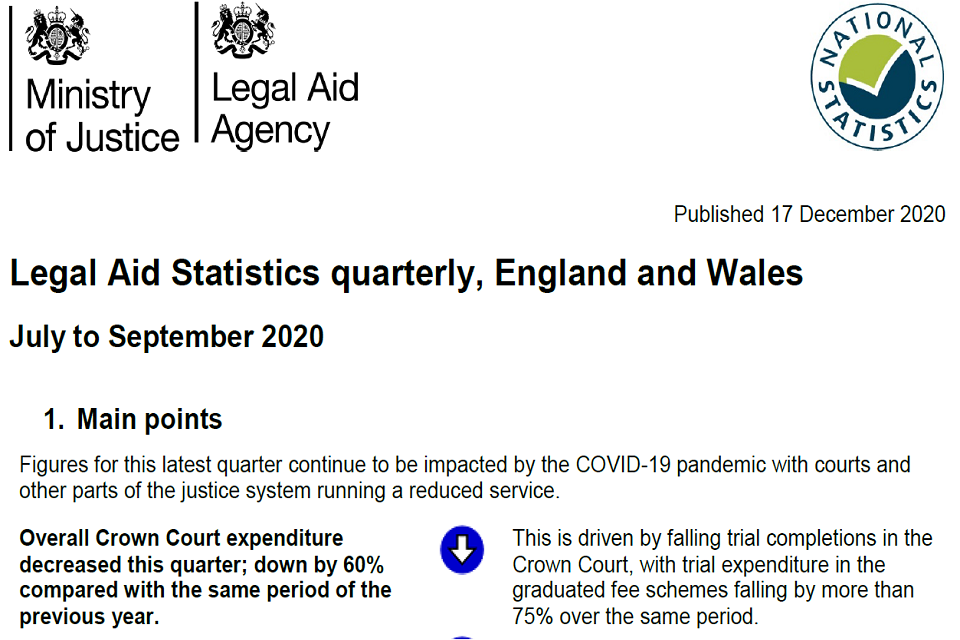
Bulletin print version in pdf
-
https://www.gov.uk/government/collections/criminal-court-statistics, Table M1 ↩
-
https://www.gov.uk/government/collections/criminal-court-statistics, Table C1 ↩
-
https://www.gov.uk/government/collections/criminal-court-statistics, Table C1 ↩
-
Figures do not include attendance (armed forces) or immigration matters. Monthly figures are therefore not directly comparable with the corresponding figures in Table 2_1 ↩
-
Figures do not include telephone operator service activity. Monthly figures are therefore not directly comparable with the corresponding figures in Table 5_1 ↩
